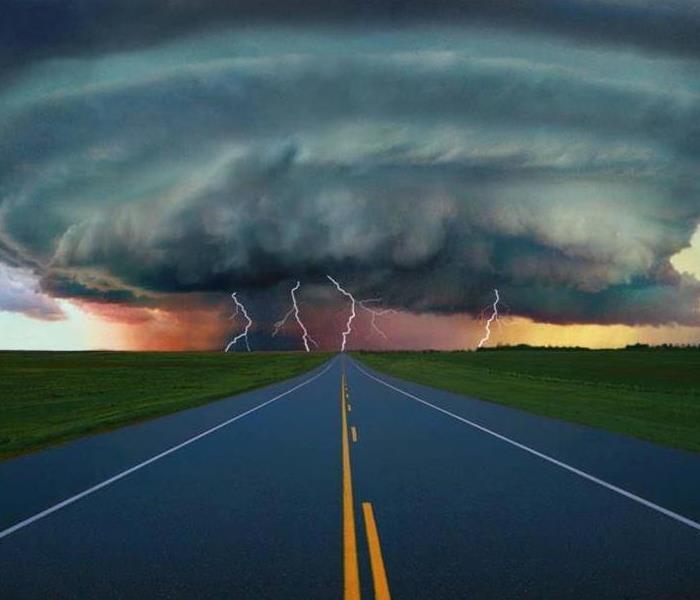Recent Storm Damage Posts
Helping Outside Our Neighborhood
10/27/2023 (Permalink)
Although we are consistently looking to help those in our neighborhood, we are always looking outside our realm to those who need assistance in drastic times, and out-of-the-norm circumstances. This is where our Storm Team comes in and travels to where you are and help in emergency situations for water damage cleanup.
When SERVPRO first gets word of a storm on its way, our crews immediately activate to check inventory, vehicle status, equipment counts, and are waiting on their toes for the dispatch request to jump into action. No matter the time of day or night- we will be headed your way with all the necessary items to assist in water damage and cleaning claims with our highly trained and efficient storm team crew members.
Our Storm Team is certified in water restoration, structural drying, and commercial cleaning services which will help provide the best outcome in such a challenging time. We will work with your insurance companies to submit claim documents, photos, reports, and keep them updated on the status of the project. With our storm crew and office staff working around the clock, you can ensure you will be in touch with the best in the business! See below a great example of our team identifying damage, removing affected materials and drying out the structure- as our team just returned from Storm Travel in Michigan and Ohio!
Traveling for storm may be a lot of work, but nothing is better than getting to reach customers outside your network, providing services in a challenging time, and knowing you are helping those in need. Storm travel means all hands-on deck, even for those working back in the home territories to continue the day-to-day operations, helping the local customers as well as aiding the storm travel crew to keep them busy and ensuring great communication for all parties. Whether you are local to us or in need of services in a storm situation- call the leaders in the mitigation field! SERVPRO- “Like It Never Even Happened”.
Understanding Storm Damage and Flooding
8/20/2022 (Permalink)
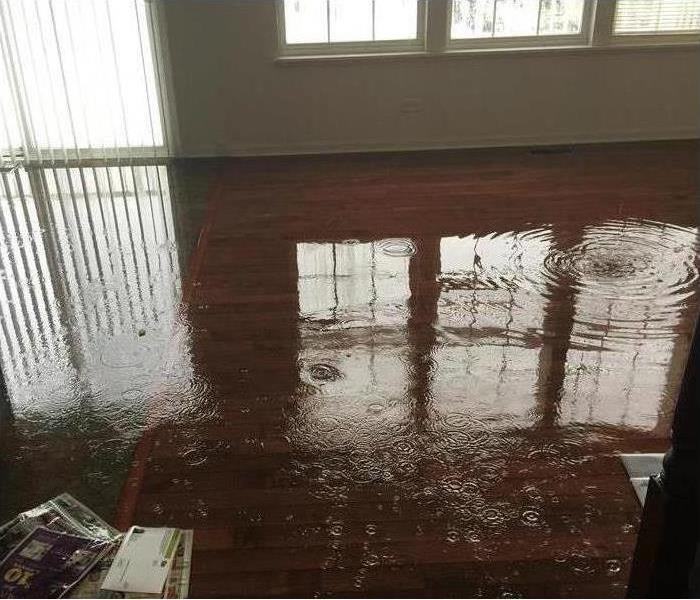 Flood damage in Batavia, IL.
Flood damage in Batavia, IL.
Storm Damage and Flooding
There are many types of emergencies or disasters that could affect your building in Batavia,IL. Water damage is one of the most destructive and concerning. This can happen in several ways, including via Mother Nature and from faulty plumbing in your facility. Both storms and flood damage can wreak havoc on your business. It's important to understand both of these — including their differences.
Storms and How They Can Cause Damage
Storm damage can send water into your building through the roof, the foundation, windows, doorways and other openings. They can also damage siding, windows, roof shingles and items inside your office. Common storms include:
- Thunderstorms with heavy rains
- Hurricanes and tornadoes with high winds
- Hailstorms
Flooding can occur in your facility when torrential rain seeps through a weakened foundation. A damaged roof may not be able to hold in the water either. Hailstones can also break glass or dent siding on the building. Powerful winds can knock over trees onto the building or damage power lines, cutting off electricity.
Floods That Don't Come From Storms
Not all flood damage is a result of the weather. A common way in which floods start in the building is from plumbing issues. A backed-up sewer line can send black water into the office, posing harm to everyone inside. Overflowing toilets can damage flooring and drywall. Also, broken pipes can causes leaks, which gradually damage building materials and develop mold. A bursting pipe can send large amounts of water into the building, threatening personal belongings and office equipment.
Help Is Available
For floods and storms, you need the expertise of a disaster response company. These professionals have the training and equipment to clean up after any damage and restore your building so you can return to work safely.
Flood damage is nothing to take lightly. Either from a storm or plumbing problems, water damage can affect your office.
Ways To Flood-Proof Your Home
7/20/2022 (Permalink)
 Laying down absorbent mulch can help to reduce potential flooding.
Laying down absorbent mulch can help to reduce potential flooding.
While you can’t totally protect your house in North Aurora, IL from every potential flood, there are some flood safety recommendations that can reduce the risk of damage.
How To Protect Your House From Flooding
For maximum flood safety, move all electrical sockets, switches, and circuit breakers so that they are at least one foot above your area’s flood level expectations.
Boilers, air conditioning units, and generators should be elevated on wooden platforms or cinder blocks above the flood level. Also, consider elevating your washer and dryer on blocks if they are located in the basement.
Install a backstop for sewage water. A licensed plumber should install gate valves to all pipes that lead into your house to reduce the risk of sewage backup into your home.
How to Minimize the Risk Outside Your Home
The following safety tips will help to reduce the risk of flooding from landscaping and other outside fixtures.
Keep all gutters and drains clear of debris. Clogged drains will increase the risk of floodwaters that cause damage.
Inspect your roof periodically to make sure the shingles are in good condition. Call a professional to replace any damaged materials before the first chance of rain.
Put a rain barrel under your gutter spouts to reduce the risk of flooding in your basement.
Evaluate the layout of your landscaping:
Outdoor surfaces that are porous, such as rocks with a bit of space between them, will encourage water to soak into the ground before it reaches the house.
You can also dig channels into the soil so that stormwater can drain away from the house.
If you have an asphalt or concrete driveway, consider changing it to brick or gravel. Also, laying down absorbent mulch can help to reduce potential flooding.
Even though you can’t totally flood-proof your house, you can implement these smart flood safety suggestions to reduce your risk.
Hurricane Preparedness Tips for Property Managers
6/26/2022 (Permalink)
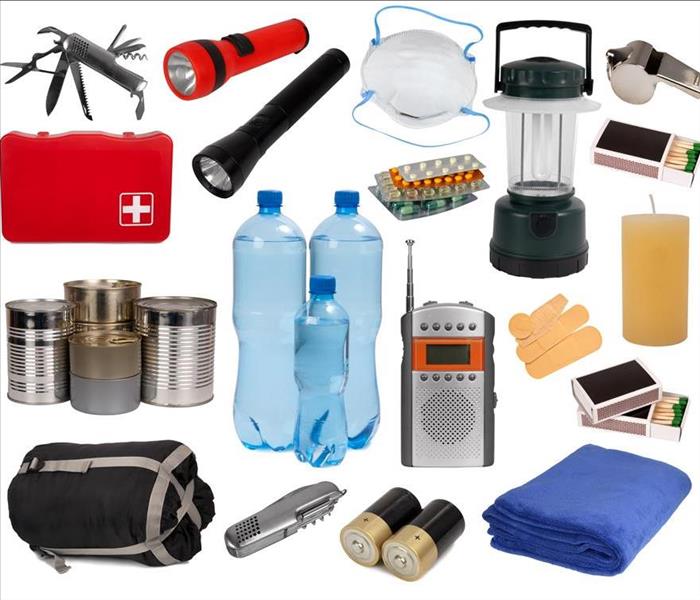 Make a preparedness kit.
Make a preparedness kit.
Hurricane Preparedness Tips for Property Managers
Going through a hurricane can bring untold stress. That’s even truer if you’re managing a property. With multiple renters come multiple potential problems, any of which could carry the risk of liability. Don’t wait until the last minute. Use these hurricane preparedness tips to prepare your Batavia, IL, property and enter storm season confident you’ll suffer little hurricane damage.
Hurricane Season Risks
A hurricane is best described as a storm on steroids. Defined by violent winds often in excess of 74 mph, these weather occurrences can cause property damage that takes months to repair. Damage can include:
• Floodwaters moving across the ground
• Mudslides due to excessive ground moisture
• Tornadoes triggered by the original storm
If your property is located in a hurricane-prone area, it’s important that you prepare for these potential impacts.
Make a Storm Plan
If you own a multi-family property, a comprehensive storm preparation plan is a must. Make sure your strategy covers evacuation plans, emergency contacts and hurricane damage relief information. Create a hurricane-preparedness team tasked with updating and communicating your plan to residents.
Secure Your Property
During high winds, just about anything can become a projectile. It’s important to secure items in advance to prevent serious damages. Survey the property in advance of the storm to identify items like large trash bins that could be lifted in a storm. If the item can’t be secured, store it inside.
Make a Preparedness Kit
Don’t forget your staff when preparing for a hurricane. Make and store kits in portable containers that can allow your staff to tend to emergencies that may occur just before or during a storm. Be sure to include staples like a flashlight, extra batteries, drinking water and a first aid kit.
Hurricane damage is nothing to sneeze at. The flooding and high winds can be a property management nightmare. Don’t risk it. Use these tips as a starting point for hurricane preparedness and enter the storm season secure.
3 Tips for Removing Odors After a Flood
4/17/2022 (Permalink)
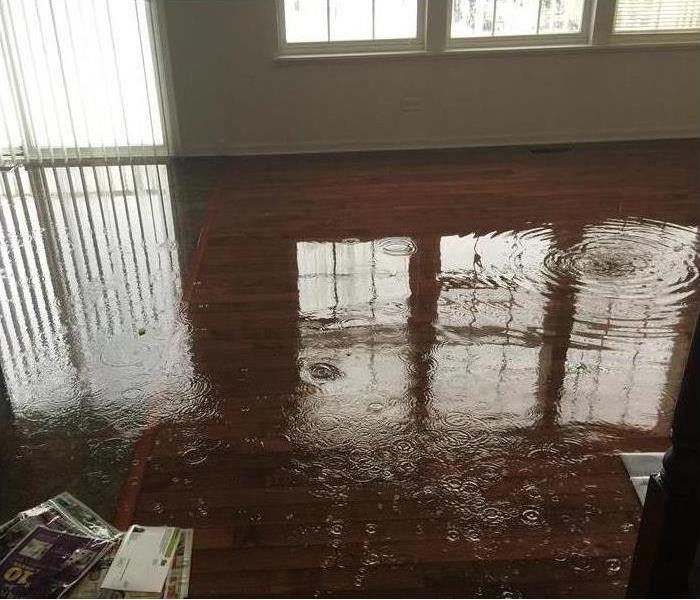 Hardwood floor water damage in St. Charles, IL.
Hardwood floor water damage in St. Charles, IL.
Tips To Remove Odors After a Flood
Water damage in buildings is a very common problem and one that can be difficult to resolve. Not only does the water itself cause property damage, but it can lead to mold growth, odors and other problems. If you are noticing odors in your building after a flood, these three tips can help you remove them.
1. Clean and Dry Your Carpets
Carpeted areas can be particularly challenging when damaged by flood water. The water can soak into the carpet pad and cause mold. It can also leave behind stains and smells. The first step is to completely dry out your carpet. You may need the assistance of a water restoration company in St. Charles, IL, to do this. Once your carpet is dry, thoroughly clean it, but do not use too much moisture, because this could lead to a new mold problem. Try sprinkling baking soda or a commercial carpet deodorizer on the carpet to absorb odors.
2. Throw Out Contents That Can Not Be Dried Out
Some types of properties, such as carpets, upholstered furniture, insulation and paper files are difficult to completely dry out, which can lead to mold growth. Anything you have that you can not promptly dry out may need to be discarded to prevent future problems such as mold and bad smells.
3. Ventilate and Deodorize the Building
One of the first things to do after sewage loss or flooding is to open as many doors and windows as possible. This helps to air out the building and aid in the drying process. You can help this process along by using a space heater, box fan or overhead fan. Using a commercial deodorizer may also help with eliminating odors.
Flood damage can cause mold growth and other issues that can lead to unpleasant odors in your building. These three steps can help you eliminate this problem before it gets worse.
3 Facts About Post-Flooding Mold and How To Prevent Its Spread
3/31/2022 (Permalink)
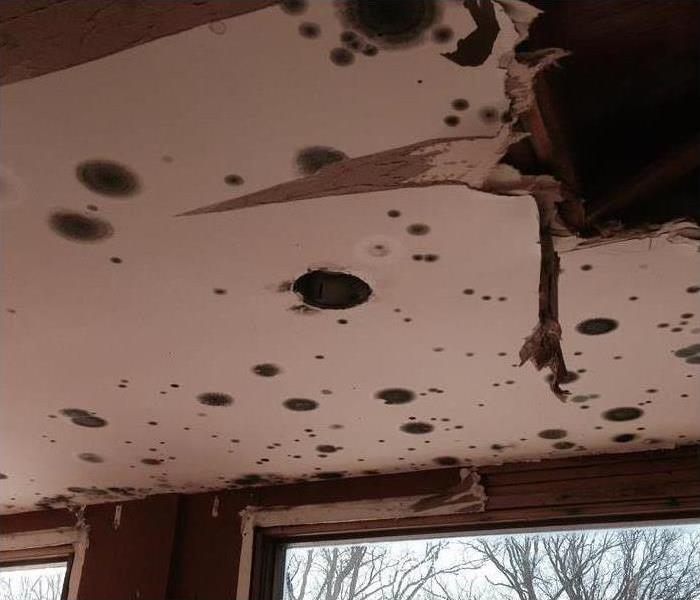 Mold damage to the ceiling.
Mold damage to the ceiling.
Three Things to Know About Post-Flooding Mold and How to Prevent It
Many problems can crop up after a flood in your North Aurora, IL, home. Foul smells, stagnant water and debris may all plague your property; however, few issues can be as troublesome as mold growth. Fungi can form as soon as a day after the flood, especially when humidity levels in your home are high. If you are battling mold after water damage, there are a few facts to keep in mind when it comes to finding growths and preventing their spread.
1. Mold Does Not Need Sunlight To Grow
Unlike many other organisms, mold does not depend on sunlight to thrive. Instead, it seeks out moist, humid areas where spores attach and begin to eat. After a flood, building materials like wood and drywall attract spores or absorb them during the flood. It can grow out of sight, inside walls and under cabinetry, where you may not notice it until you smell the odor fungi releases as it eats. After a flood, it is a good idea to have your home inspected for mold.
2. Mold Is Different Than Mildew
While both mold and mildew have a great deal in common, they are not exactly alike. Mildew tends to grow on the surface of building materials and household items, but it can generally be wiped away with a cloth and household cleanser. Mold, however, grows roots once the spores attach and cannot be easily cleaned away. Using bleach is not effective either, as fungi is not bacteria and the water content in most cleaning products may only encourage further mold growth.
3. Some Molds Require Professional Removal
Standing water and high humidity can cause severe fungi growth, including invasive black mold. Because this is a type of fungus that can be difficult to clean, you may consider calling in a storm damage and flood restoration service for assistance. Mold specialists have the experience and tools necessary to eliminate this issue and ensure it does return.
Flooding often causes sudden mold growth, which can affect your North Aurora, IL, home. Knowing how to target and remove damaging fungi can be an important step in the restoration of your property.
Protecting Your Roof From Solar Panel Damage
1/15/2022 (Permalink)
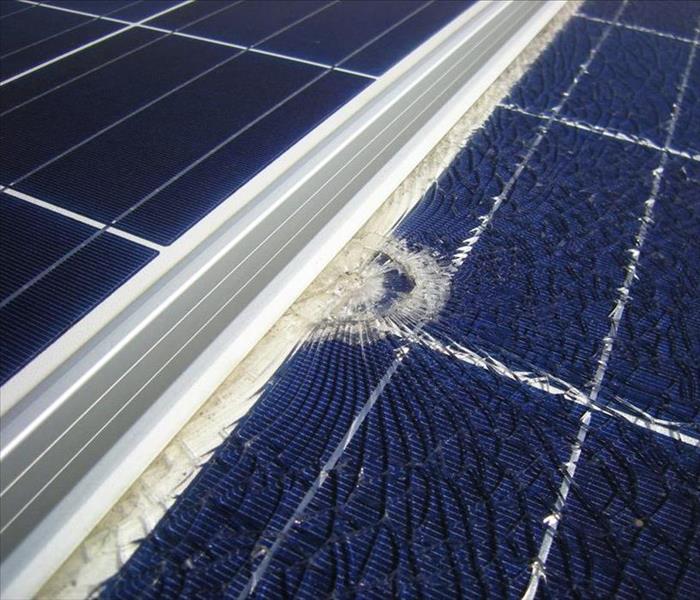 Heavy storms can cause panel damage.
Heavy storms can cause panel damage.
While solar panels are designed to withstand a variety of weather conditions, they need to be maintained. Heavy storms can cause panel damage, and it’s important to understand when and how to protect your paneling against the weather in Geneva, IL. If your panels are damaged or obstructed, you want to troubleshoot the issue quickly and return your roof to maximize energy production.
How Storms Can Damage Paneling
Storms of different intensities cause different kinds of damage:
- Hailstones break and expose paneling.
- Heavy snow can lead to water damage.
- Water damage wears away casing over time.
- Pebbles and leaves block energy production.
Panels are made of several small cells linked together. Because of this, hailstones and rocks can break apart the cells and expose the interior of the panel to moisture. While a team can repair covering if the panel damage is minimal, your best bet is to have severely broken panels replaced by a professional. If you can predict hail storms, consider investing in a cover to protect against roof damage.
How To Protect Your Panels From Damage Over Time
Water damage from rain and snow is a predictable and easily fixed issue. Over time, water can wear down the protective casing on your panels, exposing the interior and limiting energy production. Having your panels resealed periodically can help maximize your energy output.
General maintenance keeps paneling optimized throughout the year. This may include hiring a professional cleaner to maintain the panels out of reach or installing a monitoring system to keep track of energy production. Additionally, make sure to keep your panels free from debris, like leaves or stones transported by rough storms.
Solar paneling is built to withstand natural phenomena and can last over 20 years with proper attention. To inform yourself about the best ways of avoiding and addressing panel damage, contact an expert and get the most out of your energy system.
5 Steps in Maintaining a Sump Pump
9/15/2021 (Permalink)
A sump pump plays a critical part in preventing groundwater from intruding into the basement or crawlspace of your home. This pump should be fully functional during flood or storm conditions. Follow these five pump maintenance steps to ensure your pump stays in working order.
1. Inspect Your Pump Before Heavy Rains
The pump should plug into a ground fault circuit interrupter outlet and should be standing upright. Try pouring a bucket of water into the pit. The pump should start automatically, and the water should drain. If the pump is not operational, schedule repairs as soon as possible or rely on a backup method.
2. Clean the Grate on Submersible Pumps
Raise the submersible pump and clean the bottom grate on a regular basis. The sucking action can pull small stones into the grate that block the inlet and cause damage over time.
3. Schedule Annual Maintenance
Groundwater tends to rise due to snowmelt or precipitation in late winter or early spring. This is an ideal season to make sure your pump is in working order.
4. Familiarize Yourself With the Pump Alarm
Most sump pumps have battery-powered water level alarms. Some systems can send an alert to your cell phone in the event of a flood or pump failure.
5. Consider Installing a Backup Pump
Choose from water-powered pumps that work without electricity, a battery-powered pump that uses a deep cycle boat battery, or a pump powered by a car battery. Or rely on a generator.
These five pump maintenance measures will ensure that the sump pump in your home works properly. You should have a backup plan in case you lose power during a storm in St. Charles, IL. If groundwater backs up into your crawlspace or basement, contact a residential restoration company to make sure building materials are still viable and to prevent mold.
Put a Business Continuity Plan in Place
8/12/2021 (Permalink)
 Create a business continuity plan for your business.
Create a business continuity plan for your business.
Create a Business Continuity Plan
A continuity plan helps businesses remain operational during natural disasters, such as flooding. With approved plans in place, North Aurora, IL, businesses may receive premium discounts from their insurance companies. In some cases, business continuity allows otherwise unacceptable risks to qualify for insurance. With the right plan in place, day-to-day operations may continue, and the repercussions can be kept to a minimum.
Considering Benefits of the Plan
Other benefits of having this type of plan in place include:
- Increased customer confidence
- Decreased risk of injury or death
- A competitive edge
- Security of the supply chain and order fulfilment
- Business resilience
- Reduced financial losses
A business continuity plan establishes the steps and procedures administrators and employees should follow when major disruptions occur, including natural disasters
and man-made attacks on the business. The plan covers steps to take for the protection of human resources, inventory, and assets. Before it’s possible to establish a plan, it is necessary to identify areas of vulnerability and potential loss.
Creating a Continuity Plan
The first step in creating an effective plan is to identify the scope of the potential disaster. The second step is to identify crucial business areas and vital functions. The next step is outlining links between those areas and functions, giving special attention to functions that may suffer when one area of business is disrupted. The fourth step of this process is to determine how long it is acceptable for any critical functions to go down. Finally, put together the plan for maintaining core business operations during the course of flooding, snow storms, or burst pipes and a plan for bringing the business fully back into operation as storm damage and losses are assessed.
Testing the Plan
After creating the plan, it’s necessary to run a simulation to establish whether the plan fulfills its purpose. It’s best to put the plan through a challenging series of tests to improve the level of preparation. Most experts recommend testing two to four times a year. Work with commercial restoration businesses to develop a plan that keeps your business operational.
What Happens to You Solar Panels During a Storm?
7/29/2021 (Permalink)
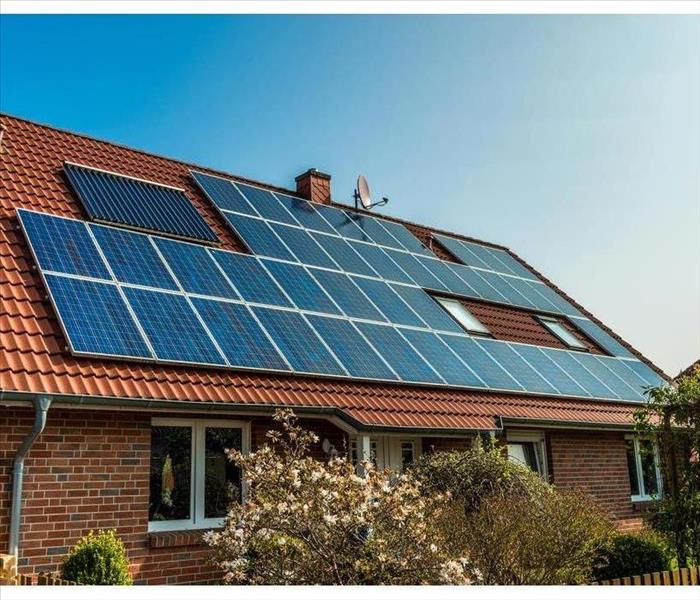 Solar panels in a house in Elburn, IL.
Solar panels in a house in Elburn, IL.
During a Storm, What Happens To Your Solar Panels?
Storms of all sizes come through Elburn, IL, during various parts of the year. Many of these storms cause little concern and do little, if any, damage to your home. This doesn’t mean you don’t worry about the possibility of weather doing harm to your home. For example, high winds, rain and other conditions may beat upon the solar panels in your roof. It’s important to understand what these items can withstand.
Hail Stones
Hail storms may be rare in your area, but when they hit, they can create problems for homeowners. You may be worried about panel damage when hail starts falling. However, you can have peace of mind knowing that these panels should be in good shape under these conditions.
• The panels are made of tempered glass and highly flexible material.
• The panels are built to withstand impact from rock, hail, or other materials.
• Panels are usually only damaged from hail when stones hit the same spot repeatedly.
Wind
This probably worries you more than hailstones, especially if you live in an area where hurricanes are common. While high winds can cause roof damage, they are much less likely to cause panel damage. This is because your solar panels are designed to withstand up to 140-mph winds. This means they can hold up against hurricanes and certainly other less potent storms.
Snow and Rain
If you purchase a high-quality set of panels, they should last 25 years or more. They are well-equipped to do their jobs well in the middle of a rainstorm or a snowstorm. The glass portion of the panels has protection to ward off any negative effects from precipitation.
When you purchased your solar panels, you may have been concerned that they would succumb to the elements. However, you shouldn’t have to worry about panel damage, no matter what the weather is like outside.
6 Tips for Extending the Life of Your Building's Roof
3/29/2021 (Permalink)
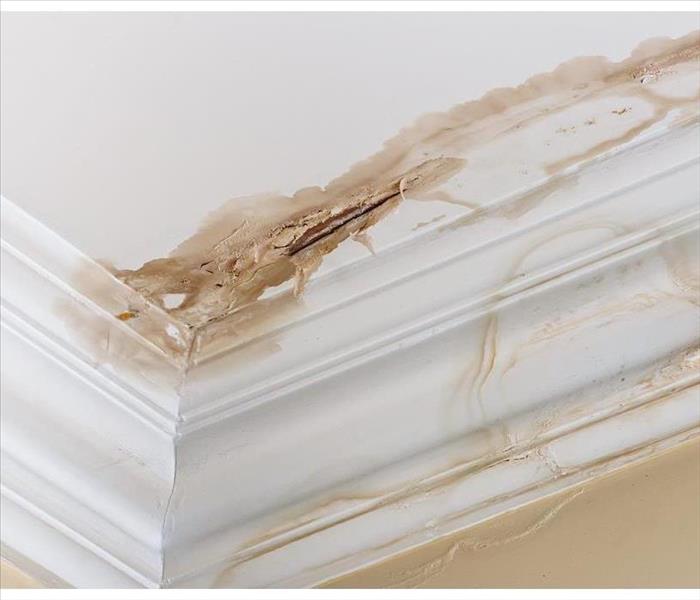 Ceiling damaged due to water leak from roof.
Ceiling damaged due to water leak from roof.
Preventive Measures To Avoid Havoc On Your Building's Roof
Even a minor roof leak has the ability to create workplace disruption. Leakages are naturally more prone to occurring when you neglect basic roofing maintenance duties. Here are six ways to help keep yours in shape so that storms are less likely to create situations where hiring a commercial storm restoration expert becomes necessary.
1. Fix Leaks
As soon as you identify water seeping into your building, have the matter fixed. Failure to do so may result in severe complications with air ducts and electrical systems.
2. Perform Inspections
Pay a professional roofing expert to evaluate your roof annually. This can help assure that any developing roof leak in Geneva, IL, is corrected before it has an opportunity to worsen.
3. Stay Off
The more pressure you place on your roof, the quicker it becomes prone to needing attention. Walk elsewhere unless absolutely necessary. If you must step on tiles, use walking pads.
4. Hire Professionals
Placing faith in the abilities of construction workers that lack experience or credentials is a bad decision. Their lower costs may be tempting, but you will likely wind up paying even more after their subpar work causes problems. Licensed professionals are much more capable of properly executing repair duties.
5. Stay Clean
In addition to wind damage, storms cause roofs to get covered in leaves and branches. Debris has the potential to clog drains and promotes algae growth. Clear your roof year-round, paying particular attention to eaves in the fall.
6. Examine Equipment
When air conditioning units leak, roofing damage is often an unpleasant outcome. Make sure yours is not the source of a worsening problem. Hire a roofing expert to handle any issue the moment one is detected.
A roof leak is the last thing any office manager wants to deal with. Thankfully, the likelihood of one occurring can be lessened with a few preventive measures. Use these tips to reduce the odds of water seeping into your building and creating havoc.
3 Tips for Preventing Sewage Backup
1/11/2021 (Permalink)
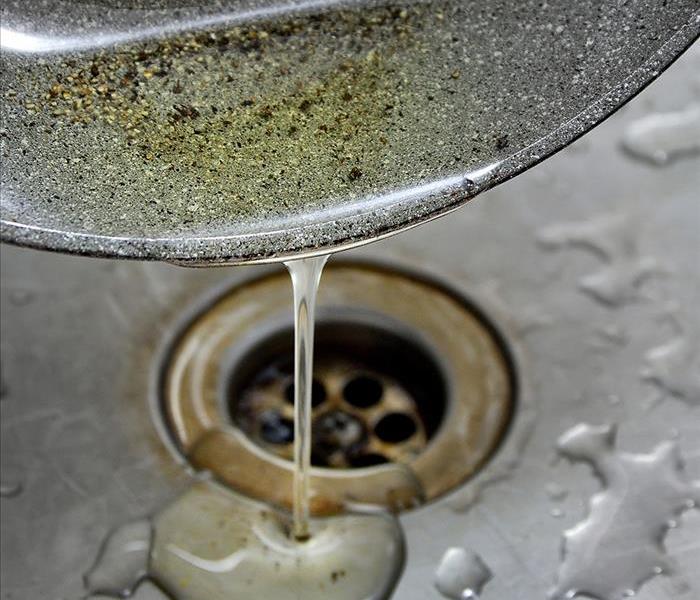 Don't pour grease down the drain
Don't pour grease down the drain
Prevent Sewage Problems In Your Home
A sewage backup can occur in your basement, bathtub, toilets, and sinks, causing flooding and property damage. Fortunately, there are steps you can take to reduce your chances of encountering sewage problems.
1. Don't Pour Cooking Oil in Your Drains
Many people attempt to dispose of cooking oil by pouring it into their sink drain or toilet. Cooking oil can harden in your drains and make it more difficult for debris, such as hair and food particles, to drain. This creates clogs in your pipes, which can lead to sewage problems. Dispose of cooking oil by pouring it into a heat-resistant container and throwing it in the trash after it cools.
2. Maintain Your Sewage System
To prevent sewage backup, keep your sewage system well maintained. Check your sump pump pit for debris that could be sucked into the pump causing damage and make sure the pump has a filter to prevent debris from storm damage from getting inside the pump. If a malfunctioning sump pump has caused a flood in your basement, consider contacting a flood mitigation company in St. Charles, IL, to remove the water. Additionally, avoid clogs by periodically having a professional sewer cleaning performed to remove the debris that can accumulate in your sewer lines. It is also a good idea to have regular inspections done to check for damage to the lines.
3. Prevent Tree Root Damage
If the sewer line that runs through your yard is older, consider replacing it with a new plastic pipe. Plastic pipes are much more resistant to damage from tree roots than lines made from clay and cast iron. If tree root issues persist, periodically trim your roots or remove trees that are too close to the sewer line.
Sewage backup in your home can pose a safety risk and lead to property damage. These three tips can help you prevent sewage problems in your home.
4 Actions To Take When Deducting Storm Damage
11/12/2020 (Permalink)
 Some of your expenses can be tax-deductible
Some of your expenses can be tax-deductible
Take The Actions Below
If your business in Batavia, IL, is impacted by a powerful storm, you are likely to have costs and expenses that affect the bottom line. In these cases, it is best to look at all possibilities for financial relief from storm damage. If the storm is large enough, there could be options for disaster relief that either provide outright grants of assistance or low-interest loans. You should also contact your insurance agent to maximize payment from this source. Finally, some of your expenses could be tax-deductible so it is important to take the actions below.
1. Contact Your Tax Professional. A tax professional will be your best source of information on what does and does not qualify for a tax deduction. While the federal laws will be fairly uniform across the nation, the rules for state and local tax deductions will vary from place to place.
2. Keep Good Records. Any tax deductions for storm damage will need to be backed up with good records. This means keeping receipts, taking photos of damage and listing all of your company's expenses.
3. Contact a Professional Remediation Company. A reputable storm mitigation franchise can be of help in many ways. A SERVPRO team can arrive on site Faster to Any Size Disaster and begin the cleanup in a matter of hours. They can also be of assistance in coordinating records for insurance payments and tax write-offs. This is critical since anything paid for by insurance will not be eligible for a deduction.
4. Follow All Applicable Laws. Tax policy can be confusing and changes occur each year. Make sure you are claiming all available deductions and following all provisions of the tax laws. Knowing the latest rules for storm damage can save you a bundle the next time your company files its taxes. Having extra money in hand can help you rebuild after a damaging storm.
5 Tips to Help Prevent Sewage Backup
10/21/2020 (Permalink)
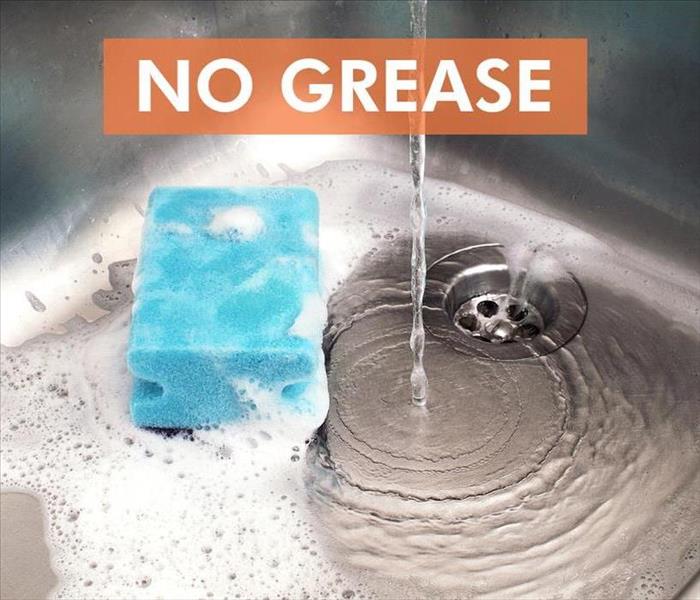 Never pour grease down the drain
Never pour grease down the drain
Protect Your Property From Black Water Flooding
Sewage backup is one of the most common causes of black water floods. These dangerous incidents contain harmful biohazards and can cause severe damage to your property in Elburn, IL. Preventing the issue in the first place is preferable than having to pay for expensive damage repairs. Read on to learn about 5 ways you can protect your property from black water flooding.
1. Take Care of Your Sump Pump.
Proper sump pump maintenance is super easy and can save you a lot of storm damage and flood related trouble in the long run. Make sure to check the filters and pipes for debris, such as gravel and silt, regularly. Also make time to test your sump pump to ensure it's working properly.
2. Only Flush Proper Paper Products.
You can easily clog your toilet by flushing the incorrect items down the pipes. Make sure that you never flush feminine hygiene products, diapers, paper towels or other thick items down the toilet. If you use multi-ply toilet paper, try to limit how much you flush at once to prevent toilet flooding.
3. Never Pour Grease Down the Drain.
Oils can harden inside your pipes, gradually slowing drainage and building up clogs over time. Instead, you need to pour the grease into a heat-resistant container and dispose of it in the trash.
4. Install Backwater Prevention Valves.
These valves can help prevent sewage backup and flooding. These devices are typically installed into your residential sewer line. They enhance sewer cleaning by permitting sewage to leave your pipes, while simultaneously preventing it from backing up into your basement or other parts of your property.
5. Opt for Plastic Sewer Pipes.
Older sewer line pipes are typically made out of cast iron, which ages and cracks over time. Newer pipes are made out of plastic, which has a significantly longer lifespan and is less likely to damage as easily.
Sewage backup floods are extremely messy and can cause a lot of damage. This is why your best course of action is to prevent them from occurring in the first place. Contact flood remediation experts if you have suffered from one of these floods.
How Long Will My Commercial Generator Last?
9/3/2020 (Permalink)
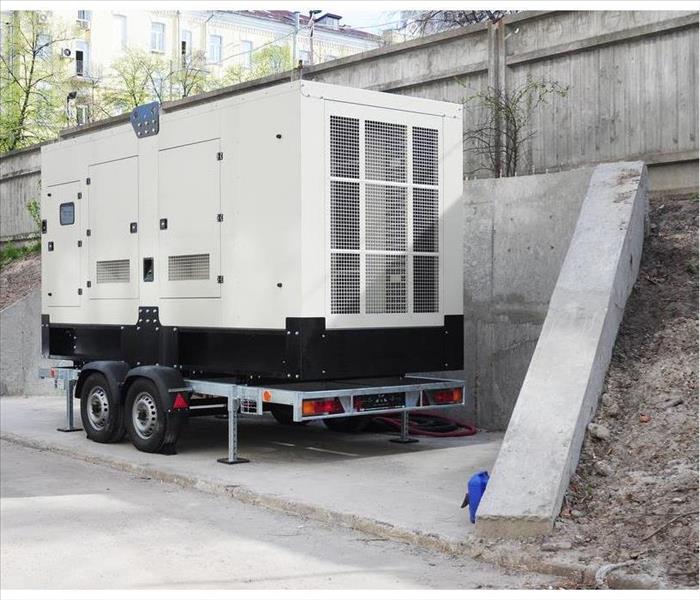 A commercial generator can be a part of a solution for your business
A commercial generator can be a part of a solution for your business
During a severe snowstorm, rainstorm, or other weather events in St. Charles, IL, it is possible for the power to go out in your building. You must be prepared for this event in advance so that you are able to keep your employees productive while you keep the business running at full capacity. When you develop your emergency action plan, it is important to include a discussion of how best to address unwanted power outages. There are many problems to consider, but a commercial generator should be a part of the solution. It provides the necessary electricity your business requires to keep it running smoothly until the power is restored.
What Energy Source Is Best for Running This Equipment?
These machines can operate on a number of energy sources:
- Natural gas
- Liquid propane
- Solar power
- Diesel
While each energy source has its pros and cons, diesel is often considered to be the most reliable and cost-efficient.
How Long Do Commercial Units Last?
The typical commercial generator lasts approximately 3,000 hours, while more expensive units can last as much as 5,000 hours. If you consider that most units are shut off in the evening and will likely only be used a few times a year, that means the machine may last 20 years. Always remember that if the equipment stops working and flooding has occurred, call a water damage expert right away.
What Can You Do to Make Your Equipment Last Longer?
Regularly scheduled maintenance is the key to the longevity of any equipment. Routine inspections can spot generator problems before they become serious, and many issues can be completely prevented if they are addressed head-on. Parts can also become clogged with dirt that prevents them from operating at full capacity. Routing cleaning and replacing of worn parts help your equipment last longer.
Purchasing a commercial generator should be part of the solution to reduce the risks of business interruption during a weather event.
Top 3 Sewage Flooding Causes
8/13/2020 (Permalink)
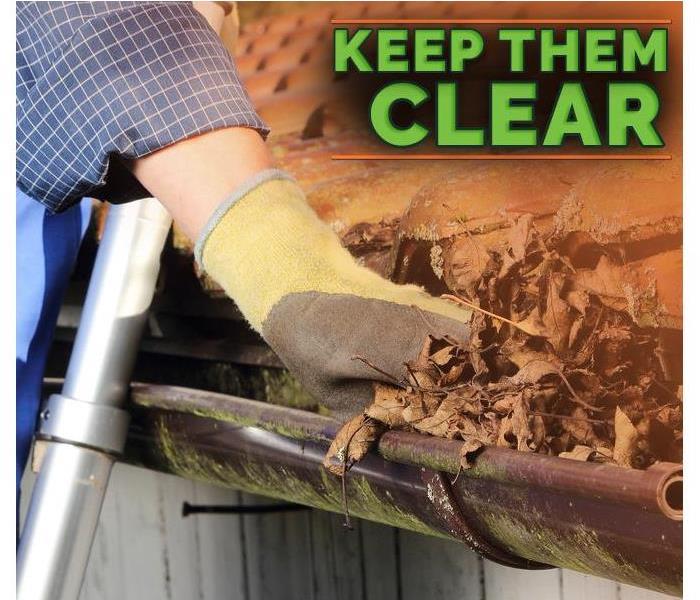 Make sure to routinely clean the gunk out from your gutters
Make sure to routinely clean the gunk out from your gutters
Most Common Flood Sources
A flooded basement is a huge problem on its own. Unfortunately, the residual water damage can lead to even more issues down the road. If your home in Batavia, IL, is suffering from sewer backups and flooding, your first course of action needs to be unearthing the source of the flood. The following are the most common flood sources:
1. Sewer Line Clogs: Check to see whether the water is rising from the drains in your basement. If this is the case, you might have to deal with a clog. The clog could be either in your home line or the municipal line. If the problem is municipal, there's, unfortunately, very little you can do. Your best course of action to prevent your drains from backing up is to install back flow preventers.
2. Surface Water Flood: There are several ways that surface water can leak into your basement. An overflowing gutter is often the culprit, so you'll want to make sure to routinely clean the gunk out from your gutters to help prevent basement flooding. Your property's landscape slope could also be an issue. The land in and around your yard should always slope away from your home to redirect water flow.
3. Subsurface Ground Water Leak: This problem is harder to detect and fix. If you can't find any evidence of surface water contributing to your flooded basement, then the source is likely underground. Hydrostatic pressure can force water into your basement, resulting in damage. The best way to prevent this from happening is to install a perimeter drain system to help alleviate the pressure. The two main types of perimeter drain systems are below-slab systems and above-slab systems.
A flooded basement is no laughing matter and needs to be taken care of quickly to prevent further issues. It's best to contact storm remediation experts if you believe that your home may be at risk of a sewage flood.
Understanding the Differences Between Mitigation and Restoration
4/11/2020 (Permalink)
 Call a restoration company when there is standing water and when the damage covers a large area
Call a restoration company when there is standing water and when the damage covers a large area
Mitigation and Restoration
Dealing with a disaster in the workplace is the last thing your business needs. Despite your best efforts and preparation, you can't prevent all types of incidents from occurring. If a major storm causes damage to your building, you need to rely on a skilled professional flood cleanup company to help you get back on your feet. The team will focus on two major components of this process: mitigation and restoration.
Advantages of Calling the Pros
For minor water damage issues in the workplace, you can probably handle the cleanup yourself. However, you should call a restoration company when there is standing water and when the damage covers a large area. Professional crews offer the following:
- Experience and expertise cleaning up after storms
- The right tools and equipment to clean up and restore buildings
- Timely response and quick results
Understanding Mitigation
Disaster response companies will first inspect the affected area and make a plan. Mitigation then begins. Depending on the size and scope of the damage in your building, technicians can complete this process in a matter of days. Crews will remove all water from the building. Then, using, high-powered fans and dehumidifiers, team members will thoroughly dry the area. After doing this, the flood cleanup company will sanitize all surfaces to kill any remaining bacteria. Technicians will tear out building materials and other damaged items.
Understanding Restoration
The restoration effort is much longer than mitigation. This involves rebuilding the roof, reframing rooms, and installing new carpet or other flooring materials. This will not take place until crews have finished all aspects of mitigation. In catastrophic flooding and storm damage, the company may have to rebuild your building from scratch.
If you choose the right flood cleanup company in Batavia, IL, you can feel good about returning to your building. The company can help make your workplace safe once more, even after the most severe damage.
Why Protect Your Home from Icy Winter Storms?
2/3/2020 (Permalink)
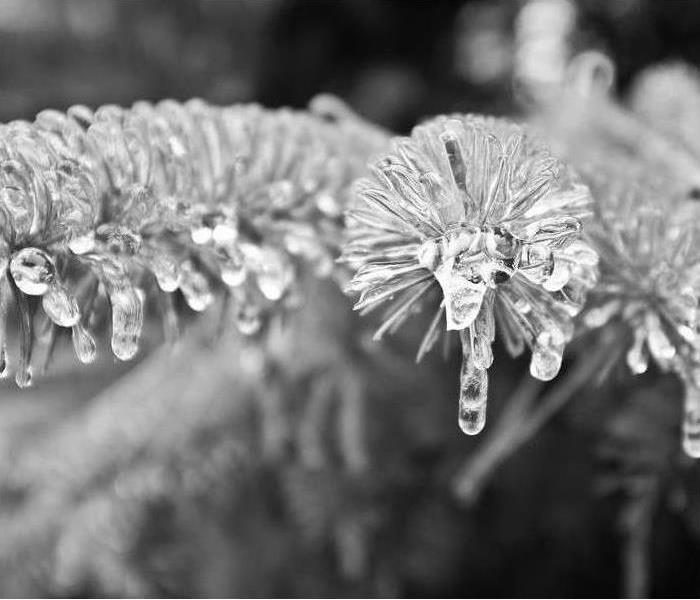 Ice storms can cause major damage to your home and property.
Ice storms can cause major damage to your home and property.
You give your kids extra vitamin C at the first sign of a sniffle. Why? Because you want to protect the things that are dear to you. Similarly, you want to protect your home from the ravages of seasonal storms – especially ice storms. Ice storms are expected this time of year. As the Tri-City’s most helpful storm damage restoration company, we are all too familiar with the damaging effects of ice storms.
Helping you to protect your home from severe weather damage might seem a little odd –after all, residential and commercial storm damage restoration is our business. But our hearts run deeper than our pockets, and we want to help our neighbors protect their home and all that is dear to them, even if it means not needing our restoration services.
SERVPRO of St. Charles/Geneva/Batavia has compiled their best tips to help you protect your home from the season’s storms.
- Trim and prune trees regularly. Even the healthiest and strongest of trees will break under the weight of ice. Broken tree limbs account for much of the storm damage from icy weather in St. Charles. A tree limb encased in a block of ice can weigh hundreds of pounds and can easily crash through roofs and even crush a car.
- Look for escaping heat. Escaping heat is often the source of icicles and ice sheets on your roofs’ edge. More widely known as ice dams, these curious ice formations can cause quite a bit of damage to your roof. Melting ice runs down and refreezes creating ice dams that block the flow of water off of your roof. This accumulated water is often the reason that we get called for water and mold damage restoration services. Prevent devastating effects of water damage to your roof by finding the source of the escaping heat causing the melt in the first place. Common sources include the chimney and even incandescent lighting fixtures in the attic.
- Keep up with regular chimney cleaning. If you use your fireplace often, then you likely clean the chimney every winter. However, if you light up the hearth only when the weather drops to freezing and skip the regular upkeep, you could be putting yourself, your family, and your home in danger. Chimneys that are not regularly cleaned and inspected are fire hazards. When icy weather is in the forecast, be sure to clean out the chimney before using it.
- Take steps to prevent frozen pipes. Frozen pipes are very likely to burst and cause water damage. Preliminary steps to protect against frozen pipes include disconnecting hoses and closing valves to prevent water flow between the indoors and out. Keeping a water faucet turned on to a slow, but constant stream also aids in preventing burst pipes and the need for water damage restoration.
Taking these steps can help to prevent icy weather damage, but for everything else, there’s SERVPRO of St. Charles/Geneva/Batavia.
SERVPRO is the most trusted name in storm damage restoration in St. Charles, Geneva, and Batavia because we’ve worked hard to earn your trust. From flooded basements to soggy, collapsed ceilings to black mold creeping up your wall from water damage, SERVPRO has the expertise and eagerness to restore your home. Call us today and let us know how we can help.
How To Prepare for Storm Season
11/15/2019 (Permalink)
 Are you prepared for a potential storm emergency?
Are you prepared for a potential storm emergency?
Ways to Prepare For a Potential Storm Emergency
Rising flood water during storm season in North Aurora,IL, can impact you and your family in several ways. It can cause significant damage to your home. It may even force you out of your home for a while. There are several ways to prepare for a potential storm emergency.
Protect Your Family
Your top priority during a storm is likely the safety of your family. You may have to leave your home with very little notice. In case this happens, each family member needs to have a bag with essential items:
- Change of clothes
- Basic toiletries
- Necessary medications
- Device chargers
- Flashlight and batteries
If you have pets, don't forget to gather supplies for them, too. Keep emergency supplies in a specific location, and talk about the evacuation plan you will use if you need to flee your flooded building.
Protect Your Belongings
If your home floods, you may have to repair or replace a lot of items. Heirlooms and other valuable belongings should be stored in a watertight container so that they are less likely to get damaged by flood water. It's a good idea to do this with your important documents, too. Better yet, have your documents digitized so that you don't have to worry about them during a storm.
Protect Your Home
Anyone who owns a home in a flood zone needs flood insurance, but this policy is a good idea even if you don't live in an area prone to flooding. Water damage from a storm may not be covered by your homeowner's policy. As soon as you know you have damage, it's important to call both your insurance agent and water restoration specialists so that you can get the remediation process started as soon as possible.
Damage from flood water may be inevitable if you live in a flood-prone area. You can still protect your family and your property with the right preparation.
The Difference Between Flood Mitigation and Restoration
10/29/2019 (Permalink)
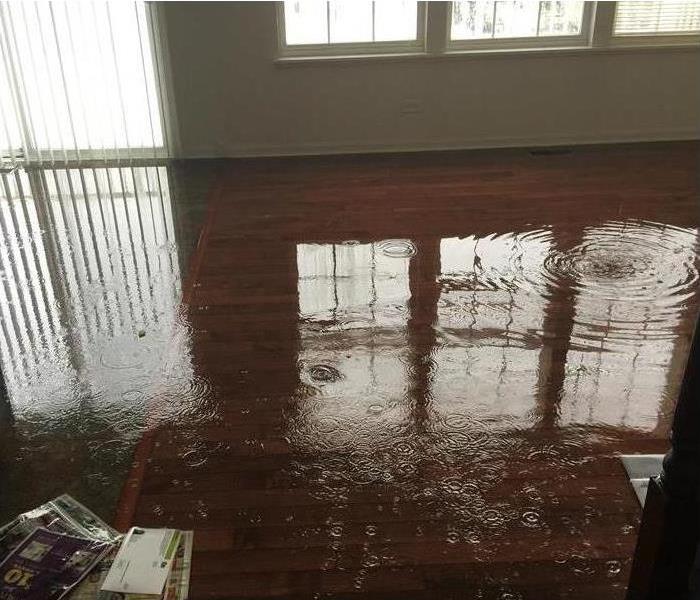 Hardwood floor flooded in Batavia, IL
Hardwood floor flooded in Batavia, IL
The Difference Between Flood Mitigation and Restoration
Knowing what to do after a flood in Batavia,IL, is critical since time is of the essence. Mitigation and restoration processes are both important after a flood occurs, and knowing the difference between them is the first step toward ensuring the safety and preservation of your commercial building and assets. A flood cleanup company provides the necessary services needed for both of these processes so you don’t have to deal with the aftermath yourself.
Flood Mitigation
The mitigation process prevents additional water damage from occurring after a flood. This mainly includes the drying process, but the restoration company will also do other necessary tasks:
- Removing all damaged items, drywall and flooring
- Cleaning and disinfecting anything that is salvageable
- Ensuring structural integrity, boarding up holes and putting tarps where needed
Mitigation does not repair any destruction. It just ensures there is no further damage done to the building, such as mold growth, theft or vandalism.
Flood Restoration
Flood restoration refers to the reconstruction or building repairs needed to bring your building back to the way it was before the damage occurred. A flood cleanup company undertakes renovations:
- Replace water damaged drywall and flooring
- Remove all mold
- Conduct moisture testing if necessary
This process cannot commence until the mitigation process has been finished. This makes certain the building is not damaged further during the restoration process.
Business Restoration
Keep in mind that doing flood cleanup on your own can cost you valuable time. Without the specialized equipment used by a professional restoration company, there could be moisture left behind that can further damage structural integrity and create mold issues.
Flooding can be detrimental for a business, which is why having it thoroughly and efficiently cleaned and restored is vital. A professional flood cleanup company can come in, set up necessary mitigation equipment and proceed with restoration so you can have peace of mind without dealing with mold problems later.
What To Watch For With Floods
9/10/2019 (Permalink)
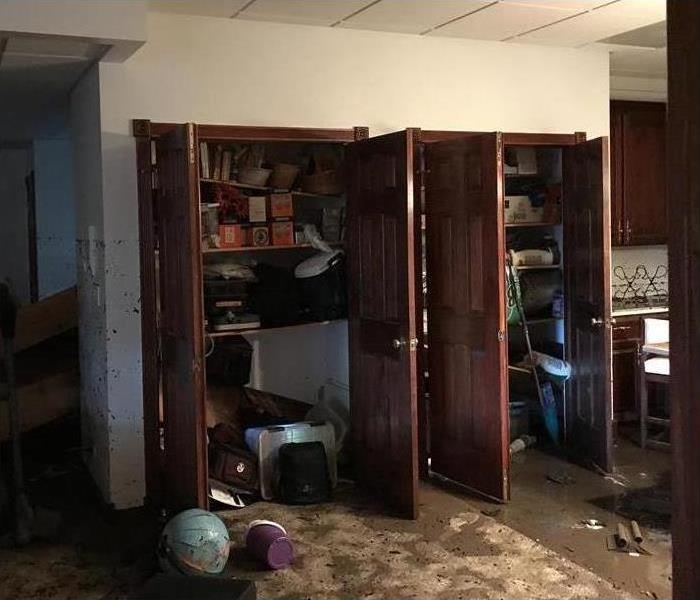 Flood damages North Aurora, IL
Flood damages North Aurora, IL
What To Watch For With Floods
During a flood watch or advisory, you may have heard that you should not drink tap water without boiling it first. Officials typically issue such advisories as a reminder to residents that floodwaters are often contaminated with chemicals and bacteria, which can pose significant risks to property and people. Some things to watch for include damage and black water.
Mold Growth
With water, mold is a key concern, as it can hide within walls and escape notice. Especially if not treated right away, mold can grow and lead to worse damage. Seeking expert help for water damage repair is smart, not only because of the safety risks but also because of the potential damage to your home. Remember that mold can linger in certain spots:
- Drywall
- Carpet
- Upholstery
- Furniture
- Wood paneling
- Ceiling tiles
Contaminated Water
Of the three categories of floodwater marked by potential contaminant types, homeowners in North Aurora,IL, want to be especially aware about Category 3, also known as black water. As the most dangerous type of contaminated water, it originates from rising water or even sewage. It may contain ground debris, disease-causing organisms or even toxic chemicals, which can pose a significant threat as well as cause water damage.
Preventive Safeguards
There are preventive measures homeowners can take beforehand to help minimize potential damage and make your home and family ready, such as raising furniture, carpets and rugs off the floor to higher ground. Another key thing to do is to stock up on safe drinking water and nonperishables to last you and your family for a while, as electricity will likely be out and cooking won’t be an option. Another thing you might want to do to prepare for a flood is place your important documents and family photos in a secure, waterproof place.
With thorough preparation and quick follow-up, repair can be managed and homes salvaged. Acting quickly can help minimize water damage, and being aware of the dangers of floodwater can also help homeowners and families stay safe and healthy.
Prolong the Life of Your Commercial Roof
8/22/2019 (Permalink)
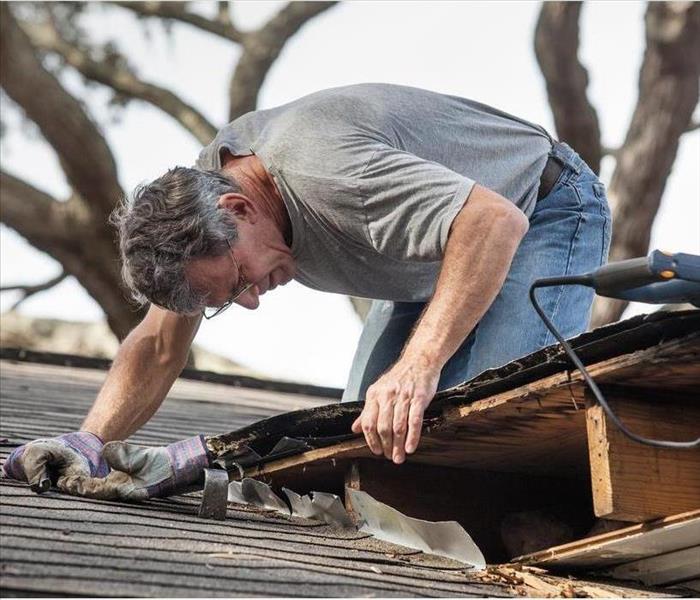 Annual roof inspections provide you with a regular update on the status of your roof
Annual roof inspections provide you with a regular update on the status of your roof
The roof over your commercial building is an essential part of your success as a company. Without it, your company would not be able to operate. It's also a significant expenditure so it pays to take good care of your roof to minimize expenses. When roof damage occurs it should be taken care of promptly or more problems will develop. One of the best ways to prolong the life of your roof is with a scheduled plan of maintenance. When you work closely with a professional roofing contractor in Geneva,IL, it's easier to catch and fix small problems. A reputable contractor can also inform you of how much longer your roof will last, allowing you to budget for a large expense.
The Importance of Inspections
Annual roof inspections provide you with a regular update on the status of your roof. It can alert you to the following common problems:
- Wind damage
- Broken or cracked roofing materials
- Improper drainage
- Flashing issues
- Premature peeling or curling of shingles
Any roof damage should be addressed quickly by a roofing specialist in Geneva,IL. It's also a good idea at this time to look for obstructions such as tree limbs that could cause damage to your roof.
The Need for a New Roof
At some point in the life of your roof, repairs will only go so far. Your commercial roof will need to be replaced. A roof rebuild is a large job so its best to consult with an experienced roofing company. Look for a company that has been active in your community and that can offer references from completed jobs. Once the job is complete, and you have a solid roof again, it makes sense to develop a plan to keep your roof in great shape. Annual inspections, appropriate repairs and eliminating obstructions will cut down on roof damage and extend the life of your roof.
Storm Preparation for Your Home
7/25/2019 (Permalink)
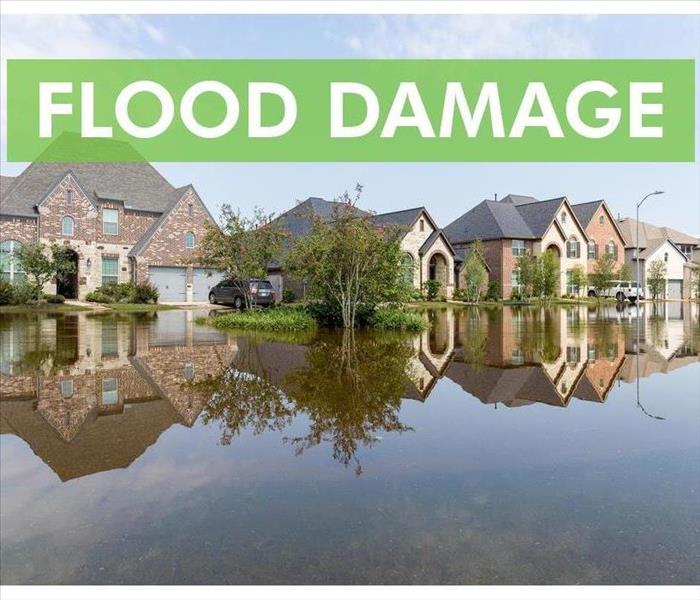 What flood zone you live in?
What flood zone you live in?
What Flood Zone You Live In?
Whether you live in North Aurora,IL or elsewhere in the country you should be prepared for a weather-related emergency. However, different kinds of storms occur in different areas which is why it’s important to know what flood zone you live in.
1. Know What Flood Zone You Live In
One of the most important things you can do to be best prepared for a storm is to know what flood zone you live in. The Federal Emergency Management Agency has identified three different types of flood zones:
- Moderate to Low Risk Areas
- High Risk Areas
- High Risk – Coastal Areas
Knowing what zone you live in will help give you an idea of how to prepare for the amount of flood water that’s expected to enter your home.
2. Sign Up for Emergency Alerts
Your local government agencies will be your best source of up-to-date information in the event of an emergency. Either the local sheriff’s office or your county will probably be your best source of information. You can choose how you get notifications, generally by a phone call or through a text. The National Oceanic and Atmospheric Administration is also a good resource for weather-related emergency alerts.
3. Keep Important Paperwork in a Water-tight Container
There’s no telling how much water damage can occur in your home if flood water finds its way inside, so you want to make sure that all your important paperwork is inside a water-tight container. Birth certificates, passports, deeds or your last will and testament are all examples of documents you want to protect from water damage.
4. Know Your Evacuation Routes
It can be difficult to think clearly in the event of an emergency. This is why you want to have as much prepared in advance as possible. If you find yourself in a flooded building surrounded by flood water you want to know the best emergency exit route before you need to use it.
If your home does get damaged in a storm you’ll want to contact a water damage repair professional as soon as possible to
What To Do After a Big Storm
7/23/2019 (Permalink)
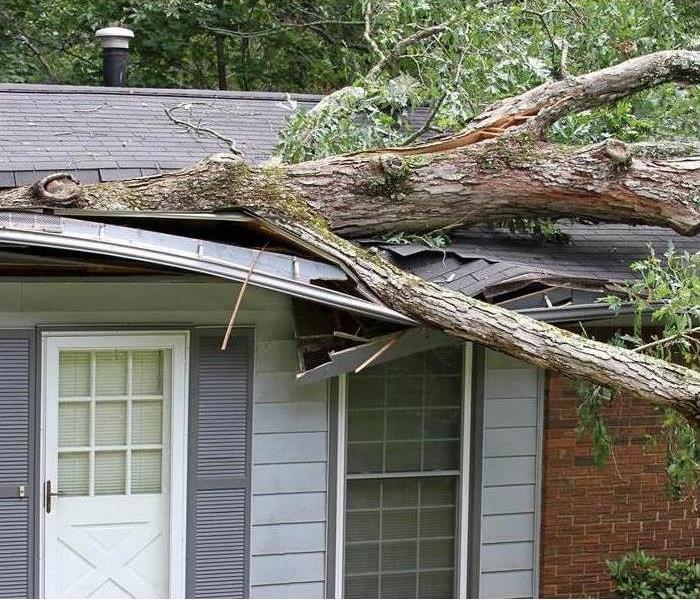 Storm Damage due to heavy winds.
Storm Damage due to heavy winds.
When large storms sweep through St. Charles, IL, many homeowners are left with some type of storm damage. Whether you have to deal with roof disrepair or flood damage, you likely want to get the problem looked at as soon as possible. If you're struggling to know what to do first, you can use this handy guide.
3 Steps to Follow After a Big Storm.
- Consider your insurance policy. Does your home have flood insurance or another policy that could help cover some of the repair costs? You may want to call your insurance company to start the claims process. However, many storm adjusters are very busy right after a large storm. While it's a great idea to give them a call, you may not want to wait until they can arrive at your house before moving forward. If you do wait, the damage done by the storm may get worse.
- Have the damage inspected. You don't have to wait for a flood insurance adjuster to start taking care of the damage. Instead, you can call in a team of storm remediation professionals. These specialists may record the damage done to your home and help you make a repair plan.
- Get the water removed. If your home was affected by flood waters, you want to make sure to address the problem as quickly as possible. If you let the waters linger, your flood damage could transform into mold damage. Make sure to take plenty of pictures of your home before any repair steps are taken.
After a big storm, you may need to have an adjuster come to your home to figure out how your flood insurance policy will affect the repair budget. However, because of an adjuster's crazy schedule after a storm, it may not be wise to wait for him or her to come to your house before starting the repair process. You need to address the damage done to your home as soon as you can.
Commercial Roof Upkeep
5/9/2019 (Permalink)
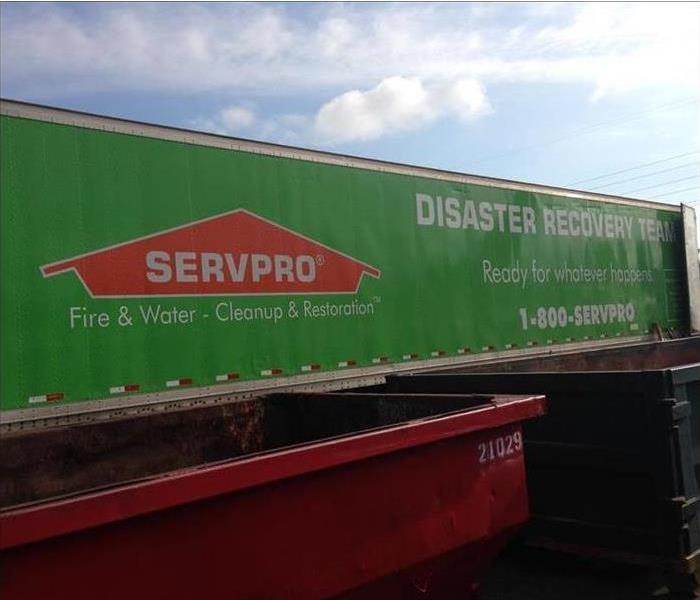 SERVPRO is available to arrive on a 24/7 basis for emergency cleaning
SERVPRO is available to arrive on a 24/7 basis for emergency cleaning
Tips in How to Keep Your Roof in It's Best Shape All Year
If you are a St. Charles,IL, business owner, you probably take a lot of pride in maintaining your business. Protecting it against roof damage is one way that you can show others how much you care about your company. Here are some tips to remember to keep your roof in its best shape all year.
1. Consider waterproofing. There are several options for waterproofing materials that seal your roof and protect it from sunlight, rain and other causes of cracks. Many can be used without professional help and are fairly easy to apply.
2. Complete some landscape work. Trees and branches can lead to wind damage or damaging debris if they are hanging too far over the roof. You do not want to run the risk of a fallen tree damaging your business and causing safety hazards. Get professional landscaping help if needed to keep your plants safely trimmed.
3. Make inspections a regular routine. Your roof should be given a thorough inspection by whoever knows the most about it at least twice each year. Damaged drainage pipes, cracks and other roof damage red flags should be addressed as soon as possible in order to avoid a complete roof rebuild.
4. Know where to get help. If the worst case scenario occurs and you are left with damage in the aftermath of a St. Charles,IL, storm, local commercial storm damage restoration specialists should be able to help you figure out a cleanup and repair plan to get your business back in the shape it was before the bad weather hit. If you need immediate help, there are many teams that are available to arrive on a 24/7 basis for emergency cleaning.
No one wants to think about the bad things that could happen to their commercial building, but taking care of your property before something urgent occurs can help you prevent any excessive roof damage from occurring in the future.
Storm Damage Prevention
4/29/2019 (Permalink)
 Storm Damage in a Commercial Building in St. Charles.
Storm Damage in a Commercial Building in St. Charles.
St. Charles Home Care: What Every Homeowner Must Know to Reduce Storm Damage
Water damage from severe thunderstorms, tornadoes, ice, and hail is an all too familiar occurrence in St. Charles and surrounding areas. Because our area is prone to severe weather, it is vital to know what you can do to protect your home. This simple checklist can help you prepare your home and minimize the damage caused by a destructive storm.
Check Your Roof and Ceiling
At least quarterly, do a quick visual inspection of the ceilings in your home. Any cracks or discolorations should be further inspected. Discoloration could be a sign of water damage and possible mold growth. If you are unsure, call an expert like SERVPRO of St. Charles / Geneva / Batavia, for a full evaluation and assessment. After walking through the inside of your home, walk around the exterior paying attention to the roof. The older the roof on your home is, the more frequently you should do a quick (from the ground) inspection. In addition, you should walk around your home after every major storm to note any new damage. If you notice any lifting or missing roof tiles, contact a licensed roofing company in your area for a thorough inspection.
Review Gutters and Downspouts
If you have trees close to your home, gutters and downspouts need to be inspected regularly. Leaves, sticks, other debris, and even critters can collect in gutters resulting in poor drainage during severe weather events. Clogged downspouts can be difficult to notice during a storm. The best test is to put your garden hose in the gutter, and turn on the water fully. This can help you assess whether it the gutters and downspouts are clear. Just as important is ensuring that the landscaping and downspouts are directing the water away from the foundation of the home.
4 Residential Flood Proofing Tips
4/26/2019 (Permalink)
 Owners of homes in areas that frequently flood may want to invest in sandbag alternatives for flood safety.
Owners of homes in areas that frequently flood may want to invest in sandbag alternatives for flood safety.
Homeowners can follow these four flood prevention and safety tips to promote flood safety and keep water out of a residence in Elburn,IL. While it is helpful to flood-proof a property in advance, residents should comply with evacuation orders to preserve personal safety.
1. Enhance Drainage
It may be possible to significantly reduce the flood risk of a property by hiring landscaping experts to adjust the grading or slope to ensure that water flows away from the foundation. Adding fill to a property located in a flood zone may enable a homeowner to obtain an amendment or revision on the Flood Rate Insurance Map maintained by the National Flood Insurance Program, which may reduce the cost of flood insurance coverage.
2. Invest In Reusable Flood Barriers
Owners of homes in areas that frequently flood may want to invest in sandbag alternatives for flood safety. Choose from water-filled cofferdams or self-stabilizing fence barriers. Absorbent single-use alternatives are also available.
3. Install Backup Prevention Equipment
Flooding can overwhelm a municipal main and result in sewer backups. A homeowner can hire a plumber to determine whether preventative mechanisms such as a backflow valve, standpipe or overhead sewer could be effective solutions for flood proofing a basement.
4. Anchor or Elevate Critical Components
If flooding is anticipated within days or hours, homeowners should make every effort to promote personal safety while limiting losses. Anchor or elevate critical components such as fuel tanks, generators and HVAC units. Raising indoor electrical components can also reduce electrocution risks. Relocate as many appliances as possible above the anticipated flood water level.
These safety tips can reduce the likelihood that flooding will result in extensive damage and losses at a residence. In any case, flood safety is the primary concern. If a residence suffers damage, mitigation and restoration specialists can quickly arrive on site in Elburn,IL.
Flood or Storm Damage: When is a Flood a Flood
2/13/2019 (Permalink)
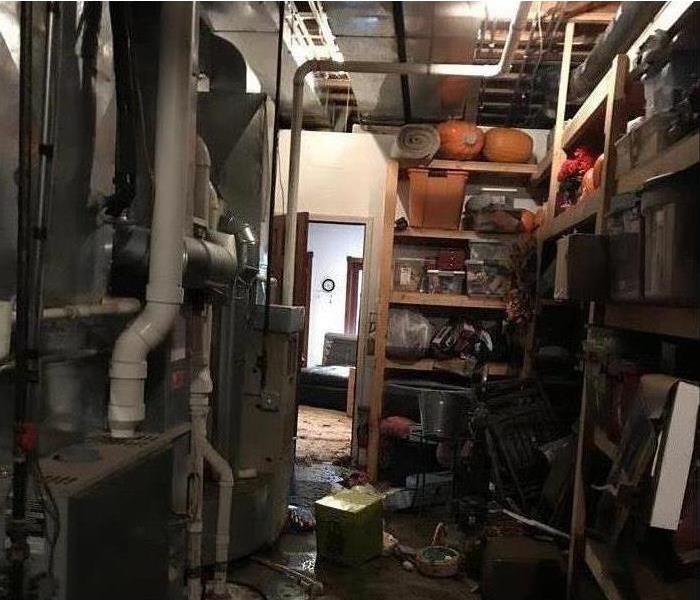 Flood Damage in Batavia, IL.
Flood Damage in Batavia, IL.
Definition of Flood And Stormwater Damage
Flooding is one of those issues that causes a lot of controversy around the idea of insurance coverage. While flood damage requires individual riders and sometimes special policies, storm damage is often covered under a typical business policy. Why is that, and what exactly is the difference between flood and stormwater damage? The critical issue is in the definition of flood and stormwater.
1. Flood Water
Flood water is defined by territory and natural formation. Therefore, overflowing rivers, lakes, creeks, watercourses and dams are considered floods. Water overflowing from these areas and into your building will require coverage from an individual insurance rider or policy.
2. Stormwater
Stormwater refers to water overflowing from drains due to backups or rainwater. This type of flood damage is considered damage from a storm or other humanmade issue. However, while most policies will cover this type of damage, you may require special insurance coverage for your surrounding property or possible business interruption.
3. Water Damage Overlap
There are instances where both rainwater and overflowing rivers cause flooding. In these instances, it is up to your insurer what items are covered or not, likely anything explicitly caused by rainwater and damaging your property will be covered, but this can be hard to prove.
4. Water Coverage and Recovery
The most practical thing to do is to get a flood insurance rider if you are in a moderate to high-risk flood zone. By covering multiple possibilities, you can ensure a better outcome. Call your insurer or a flood remediation specialist in the Batavia,IL, area to discuss your options further.
Flood damage is unique in that its causes vary wildly from natural occurrences to humanmade crisis but that it is not as broadly covered by insurance policies. Insurers define flood water and stormwater in different ways which may result in the necessity of multiple policies or riders.
Storm Flooding
12/7/2018 (Permalink)
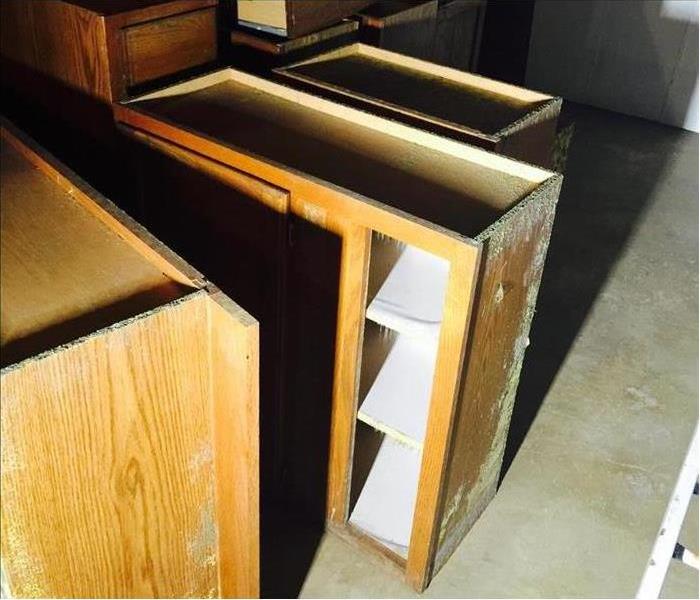 Mold on Cabinets
Mold on Cabinets
Managing Stress From Storm Flooding
Summer is a time to relax and be carefree, but this past June, summer in St. Charles proved to be otherwise. Local creeks overflowed with the sudden 5" rain downpour, reminding us of the 2008 St. Charles storm flooding. Natural disasters like these and those we saw in Louisiana, take a toll on you emotionally and managing your stress is a vital part of the recovery process.
SERVPRO of St. Charles, Batavia, and Geneva know all too well the anxiety you feel --we’ve aided hundreds in your community with storm damage restoration in the severest of weather.
Resilience, or the ability to bounce back quickly, is essential to managing stress after a traumatic event. Helping you, your family, and your home recover quickly is our goal at SERVPRO. Here are ways that SERVPRO customers that were in your situation managed their stress and built resilience after severe flooding.
Make Connections
Stress not only makes you feel wound up and uneasy, but it can also make you feel isolated –further magnifying your stress and delaying emotional recovery. Look to create connections with others to ward off feelings of loneliness. Seek others that were also affected by flood damage in St. Charles. Sharing your experience and listening to theirs is a simple but useful tool to lessen flood-related stress.
Limit News Stories on the Flood Damage
While keeping up with flood warnings is a good idea, try to limit general news coverage on storm flooding. Watching graphic images of floodwaters wreck havoc on your community heightens your levels of stress and can even make you feel as if you are reliving the trauma.
Care for Your Body
Emotional distress takes an immense toll on your body. It’s a burden that feels heavier when healthy habits are also lacking. Even the smallest of changes can have an enormous impact on your health and overall well-being. Taking daily walks, practicing mindful breathing, and reaching for a glass of water instead of soda or juice all add up to significant stress reduction and a resilient self.
Remind Yourself That Brighter Days are Ahead
Inch-by-inch, day-by-day, recovery is happening. In fact, you may be surprised at how fast storm damage restoration to your home can occur. At St. Charles SERVPRO, also serving Geneva and Batavia, we understand that a critical part of your emotional recovery is restoring your home. That’s why we promise to you that we will be at your home or business within hours of your call –not days. Starting the cleanup as soon as possible helps to reduce the water damage to your home and also reduces your anxiety. To help further ease your stress, SERVPRO of St. Charles helps you with the flood claims process, allowing you to focus on more important matters –like yourself and your family.
Save this phone number on your cell, (603) 377-7063, and rest assured that stress-free, hassle-free storm flooding restoration is moments away.
5 Reasons Your Business Needs Flood Coverage
8/20/2018 (Permalink)
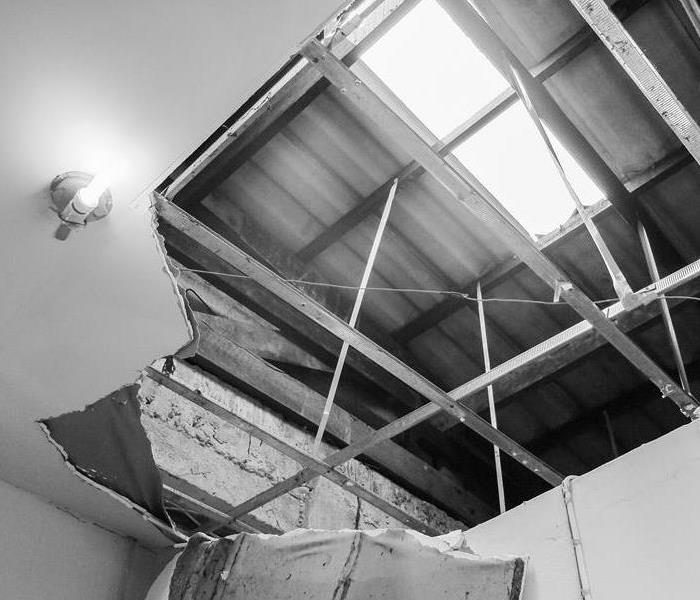 Flooding can occur from storm damage after a severe storm in the St. Charles area.
Flooding can occur from storm damage after a severe storm in the St. Charles area.
When it comes to flood insurance for your commercial building in St. Charles, IL, you may think this is an extra policy you don't need. After all, won't your commercial policy cover any water damages done to your property? However, most commercial storm damage restoration professionals will tell you this is coverage you should get for your business.
1. Flooding might not be covered by property insurance. This of course depends on your policy, but most commercial insurance policies don't help pay for damages done by flooding caused by storms. Your policy could cover some sources of water damage, but you may feel better if you equip yourself with a policy that provides more protection.
2. It can help you replace your belongings. If your business equipment is damaged during a storm's deluge, you may be able to get some help replacing the items. This assistance can help you get your company back up and running quickly after a disaster.
3. It can cover you from various sources of flooding. Most flood insurance policies will cover a wide range of standing water sources, including ice dams, overflowing rivers, blocked sewage systems or snow melt. Talk with your insurance agent to find out which ones apply for your coverage.
4. You may be at a high risk for flooding. Some areas have a higher flood risk than others. If your property is in a low-lying area or hurricanes are common in your locale, you may want to strongly consider adding a specialty policy to your coverage.
5. It can help you remove mold caused by standing water. After water permeates your building, you have a risk of accruing secondary damage, such as mold growth. Many policies for floods will help pay for restoration after mold damage is found.
Flood insurance can help protect your property and your business from damages caused by a storm. Without a special policy added to your property insurance, you may have a major gap in your coverage.
For more on St. Charles click here.
How FEMA Can Help After a Storm
7/28/2018 (Permalink)
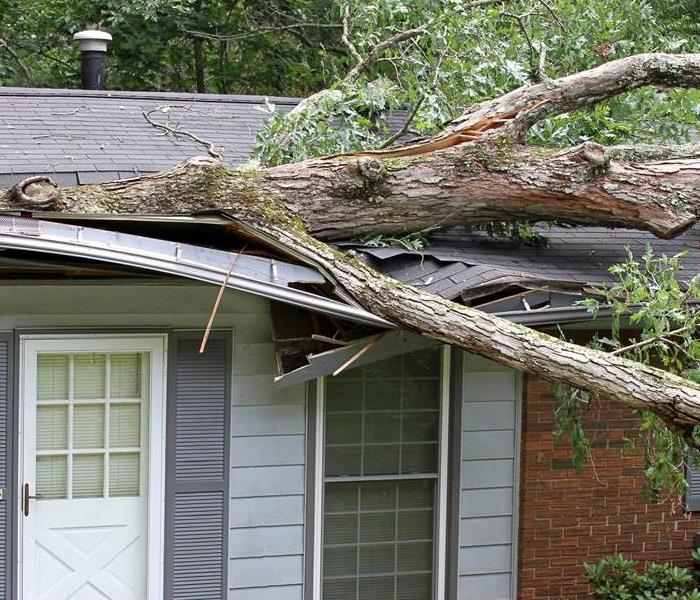 Storm Damage in St. Charles Illinois
Storm Damage in St. Charles Illinois
A hurricane or storm can leave terrible damage to homes in St. Charles, IL, but there is help. The Federal Emergency Management Agency (FEMA) can help homeowners get back on their feet following storm damage. Below is an idea of what to expect in the event of a hurricane in your area.
• Registration
The first step in the process is to make sure you are registered with FEMA. The easiest way to register is to go online at www.DisasterAssistance.gov or to download the app. You can also call 800-621-3362 to get started over the phone or visit a Disaster Recovery Center in the event that you do not have internet access.
Be prepared with your Social Security number, address, income, insurance information and bank routing numbers, in addition to a detailed description of the damage to your home. Some homeowners have to submit a Small Business Administration loan application before their eligibility is determined. You’ll be given a nine-digit registration number to use for all future correspondence.
• Inspection
After registration is complete, the agency will contact you to set up a home inspection. They will assess any flood damage to the home during this time. The inspector should display his or her identification when he or she arrives. Homeowners or renters will be required to prove occupancy or ownership at this time, so be prepared with a payment receipt or rental agreement and government identification.
• Follow-Up
Following the inspection, registrants will receive notification about their applications via mail, email or text. Be sure to read everything because often times, people have to submit further documentation. If you aren’t sure what the letter means, you can contact the helpline at 800-621-3362.
No one wants to deal with flooding or the devastation of a hurricane, but fortunately, there is help. FEMA exists to help homeowners through this situation and get back to their normal lives as quickly as possible.
For more on St. Charles click here.
Timely Intervention: The Key to Mold Prevention
7/23/2018 (Permalink)
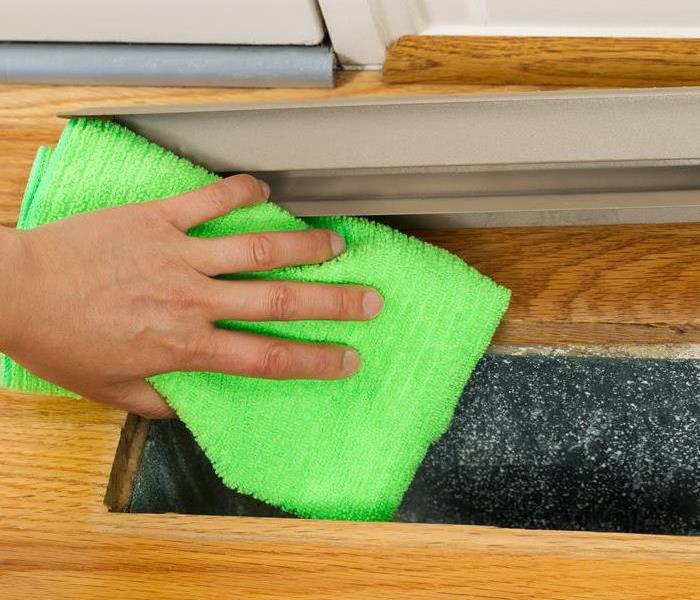 Air Duct cleaning in St. Charles
Air Duct cleaning in St. Charles
If your commercial building in St. Charles, IL , is prone to mold problems, it is likely that you need to adjust your prevention measures. Early detection of the problem and remediation by certified specialists is key to taking care of it. If you want to prevent the problem in the first place, however, engaging in regular maintenance such as carpet cleaning, air purifying and HVAC servicing is helpful.
Early Detection
Water leaks can occur anywhere there is a source, even if you think the source is secure. A building may have cracks, allowing water to seep in from outside. Well-sealed buildings can also experience mold growth, though, as poor ventilation can cause condensation to form when moisture in the air cannot escape. There are several other ways water damage that lead to mold issues can occur:
• Frozen or broken pipes
• Loose supply lines
• Ice dams causing roof leaks
• Poorly planned landscaping or gutter systems
• Overflowing toilets or sinks
No matter what causes the issue, it must be resolved so that mold doesn't grow. If mold spores find a moisture source, you will likely experience a problem.
Preventative Measures
Regular maintenance of your commercial property can help prevent mold problems Routine carpet cleaning, particularly in high traffic areas where excess moisture may occur, is necessary. Set up a regular schedule for HVAC testing and cleaning to make sure that your air ducts don't have mold growth. Consider using HEPA air purifiers with activated carbon filters that draw mold spores out of the air to destroy them. Finally, something as simple as placing door mats at each entrance so that employees can leave the spores from outside that have hitched a ride indoors on their shoes at the door.
Air duct and carpet cleaning should be a part of your regular building maintenance plan. By keeping on top of your maintenance schedule and taking care of water leaks when they occur, you are more likely to prevent mold issues.
For more on St. Charles click here.
Getting Rid of Bad Odors After a Flood
1/31/2018 (Permalink)
Flooding in St. Charles, IL can have a lot of consequences for your home, not the least of which is the bad odor left behind even after the water is gone. Prevent your property from being flooded with unpleasant smells, or, if they are already there, get rid of them by taking a few simple restoration measures.
Preventing Odors
Odors after flooding can be the result of mold growth. Mold can easily grow during and after flooding because of the moist conditions created by the water. Mold usually creates a stale or musty odor that can be quite unpleasant. One of the best ways to prevent this can be to stop mold from ever growing in the first place. Since fungus grows fast, as quickly as during the first 24 hours after flooding, you’ll need to act fast to keep it away. A restoration service can help you accomplish this by doing the following:
• Tearing out damaged drywall and other wet materials
• Dehumidifying the home
• Using bleach or other products to kill any remaining mold spores
While you may not be thrilled at the thought of replacing carpets and other materials, it can be worth it in the long run to avoid bad smells and worsening damage.
Removing Odors
If your home already suffers from nasty odors, one way to fix it can be to disinfect the areas where you believe the smell is coming from. Even if mold growth is not immediately visible in these areas, microorganisms left behind from the flood water may still be present.
Restoration services can be useful in these situations as well and can help you make sure the disinfection process is completed safely and thoroughly. Again, while some items can be deodorized and salvaged, others, especially porous materials, may have to be replaced.
By preventing mold growth, you can avoid the unpleasant odors left behind after flooding. Stop smells before they happen by replacing damaged materials and drying out wet areas as quickly as possible.
Visit http://www.SERVPROstcharlesgenevabatavia.com for more information on storm damage.
Why Is the Restoration Technician Cutting into the Building’s Walls?
12/1/2017 (Permalink)
Why Is the Restoration Technician Cutting into the Building’s Walls?
Few things can be more worrisome or stressful for a small business owner than a flood in a commercial building. As you watch waters rise, you see hard work and profits go down the drain. Following a flood in St. Charles, Illinois you’ll likely want to work with a restoration company to return your warehouse, office, or other commercial building to its pre-flood state. You probably don’t, however, want to further harm the property. As such, you may wonder why the flooding restorer is cutting into your commercial building’s walls.
Understanding the Flood Cut
During a flood, water can get virtually everywhere inside a commercial building. Because of this, restorers often must tear out drywall to allow water to drain. These cuts increase airflow, promoting drying of wall studs. Technicians generally make flood cuts 12 inches above the flood line. After they do so, they remove damaged drywall and insulation.
Preserving Existing Walls
No two floods or commercial buildings are identical, so restoration technicians usually must make a unique plan to deal with flood waters. Sometimes, restorers can avoid making flood cuts. If your company’s flooding did not involve contaminated water, technicians may try to preserve drywall instead of remove it. Also, if walls don’t have insulation, professionals may be able to successfully restore the property without cutting into the walls.
Taking Additional Steps
Following a commercial flood, restorers must take additional steps to ensure your business property retains its value. Generally, they do the following:
- Completely remove damaged flooring and walls
- Target dangerous mildew and mold
- Clean heating and air conditioning systems
Flooding can destroy any business in St. Charles, Illinois Fortunately, by collaborating with a qualified restoration company, you can likely restore your business to its pre-flood condition. While it may be difficult to watch restorers cut into your building’s walls, flood cuts may be the best way to save your company from long-term damage. Visit http://www.SERVPROstcharlesgenevabatavia.com for more information on water damage.
Deodorizing After a Flood
12/1/2017 (Permalink)
Deodorizing After a Flood
Mold growth and sewage loss after a flood in St. Charles, Illinois is a significant danger, and one that generally can’t be avoided. Once the flood water goes down, you may be left wondering how you’ll make your space usable again. Here are a few tips to help.
Work Fast
Sewage backflow is a problem that needs to be addressed quickly. Black water (heavily contaminated sewage) often causes serious illness and should be handled by a professional. Even gray water (unclean water that is not necessarily deadly) can cause health problems if it is not disposed of properly.
Contaminated water might include:
Microbes that are dangerous to your health
Harsh chemicals
Viruses and bacteria
Mold spores
Watch for Mold
After a flood, mold spores are ever present. They become a problem when they bloom and evolve into colonies. That growth is a fast process in a damp environment. As soon as you’re able to remove flood water and begin dehumidification, do so. Not only will you save yourself on water damage, but you’ll reduce the time that mold has to grow.
Call a Qualified Professional
Leaving standing water in your building any longer than necessary will impact more than just the contents of your building; it will increase the odds that standing clear water will turn into dangerous gray or black water. Eliminate the risk of mold growth and illness by calling in a professional as soon as possible.
A qualified restoration contractor will have the knowledge and equipment to deal with your sewage loss quickly and efficiently. They’ll safely remove all excess moisture from your structure, and then reduce the mold levels in your property to normal levels. This eliminates the odors without tricks or shortcuts. They’ll use processes like air filtration and mold containment to disinfect and deodorize your property appropriately.
Flood water causes a lot of damage, both seen and unseen. A qualified professional can help you remove sewage loss and mediate mold growth properly in order to minimize the damage. Visit http://www.SERVPROstcharlesgenevabatavia.com for more information on flood damage.
Picking Up the Pieces After Storm Damage
9/27/2017 (Permalink)
Picking Up the Pieces After Storm Damage
When you are struck by a major storm, whether it is a hurricane, a flood, strong winds, or a winter blast, it can turn your whole world upside down. Storm damage can be considerable. River flooding or flooding of any kind is a typical result of hurricane damage. Ground water and flood water can rise to alarming levels. It can enter your home and cause destruction. Your flood pump may not be able to keep up with the water that rises in your basement. The end result is a serious need for storm remediation. No matter what kind of damage you have, whether it is hurricane damage or ice damage, you are going to need help when it is time for home restoration after the storm has finally over. When it is time to pick up the pieces, call in the experts for storm damage restoration.
Taking Those Initial Steps
Once the storm has passed, you will be left with the damages. It is too overwhelming to try and manage the home restoration process on your own. When you bring in a professional team that knows about storm restoration, it will be possible to turn your disaster around. They will begin with an evaluation of your home. They will look at hail damage, water damage, and wind damage. They will consider the presence of flood water or ground water in your home. They will assess roof damage caused by a roof leak and determine what type of roof repair work is needed. If it is winter time and you have ice damming, frozen pipes, and ice damage, a plan of action will be determined to suit your needs. Once your professional storm restoration team has completed their initial evaluation, they can concentrate on storm remediation.
Breaking Down the Damages
When you are facing hurricane damage, wind damage, hail damage, and water restoration are going to be major issues caused by extreme storm damage. River flooding or flooding are typical problems that must be addressed, leaving water behind in your home. A flood pump can be used to remove any signs of flooding. Your professional storm damage restoration experts will take care of the process of removing all signs of flooding or river flooding. They will use the flood pump to get rid of ground water or flood water that lingers in your home. When it has no place to go, a flood pump can get rid of it as part of storm remediation. Roof damage is another issue. Wind damage, hail damage, and hurricane damage in general can result in considerable roof damage. When there is a roof leak, roof repair is necessary to avoid additional water damage throughout your home. Water restoration is possible, as well as home restoration, when the roof is sound once again in order to continue in the process of storm remediation.
Dealing with Winter Storms
When storms strike in the winter, ice damming is typical. Ice damming creates an ice dam on your roof that can cause severe roof damage. Ice damming can be a major source of ice damage that will leave you with a mess. Your storm restoration team can take care of all of the problems that come with an ice dam. They can remove the ice dam and look at roof leak issues that require roof repair. Once the ice dam is gone and a roof leak is located, they will complete all roof repair work. Frozen pipes are another issue. Frozen pipes can result in a break or flooding in the basement. Your storm restoration crew can take care of the damages brought on by frozen pipes in order to complete storm remediation.
It's Time to Clean Up and Achieve Home Restoration
Once all issues have been addressed from river flooding, wind damage, flood water, and ground water, water restoration will be achieved. Put any kind of damage, from hail damage to ice damage behind you. With water restoration services, all services will be sanitized. Anything that has been damaged will be repaired. Fresh paint and drywall will help you to rebuild. You can have a fresh start when you turn to the professionals.
Visit http://www.SERVPROstcharlesgenevabatavia.com for more information on storm damage.
Water Damage Restoration Tips
4/28/2017 (Permalink)
Water Damage Restoration Tips
Folks who have lived on the east coast for any length of time are fully aware that some of those areas are tornado prone and that Mother Nature provides an opportunity for damage to be done. You should also know, or be aware, that it's not just a tornado with high winds that can cause havoc. Things as simple as a broken or damaged concrete slab can produce water in home, as well as water in business. Water damage may not reach the status of a 100 mile per hour tornado, but the flood damage can be annoying and costly. Actually, in a recent survey, it was found that water slab leaks are quite common in Florida and hard to detect.
Mitigation And Water Damage Restoration
There is not a whole lot worse that could happen to a person than standing knee deep in smelly water in your basement with thoughts of drying, water cleanup and air movement running through your mind. Well, maybe you were not prepared for this water damage and flood damage episode, but to prevent future problems of water in home or water in business - think: water damage restoration and mitigation. You should also understand that mitigation should be handled by an experienced and licensed professional water restoration contractor, not your neighbor or your cousin Bob. That said, if you are a homeowner or business owner with a water damage or flood damage conundrum, let's do a question and answer primer.
#1 - What are the effects of water damage, flood damage, water in home or water in business as well as water cleanup? If water makes a direct hit, it will cause drywall to sag, and fall apart. If wood is involved, it will swell and buckle, then rot.
#2 - Can water in home or water in business be prevented? There is not much you can do to an act of nature. But strangely enough, most significant water damage or flooding damage is caused by indoor plumbing failures like a leaky underground pipe.
#3 - How long does it take for the drying process or complete water cleanup? Mostly, drying and water cleanup will depend largely on the extent of damage, saturation and how long the water in home or water in business has been exposed to water.
Restoration, Air Movement, And Mitigation!
Using a certified restoration company to handle the drying, air movement, water cleanup and overall water restoration is best left for the professionals. They know why the air movement feels dry and usually have been in the water damage restoration business a long time.
Note: If you are wondering why a water damage restoration company would need to have access to your water in home or water in business once the water has been extracted and the drying process has begun, the professional contractor will need to continue monitor and control the moisture, humidity levels along with the air movement until everything in the environment is returned to normal and no mold threatens. Visit http://www.SERVPROstcharlesgenevabatavia.com for more information on water damage.
Protecting Your Home from Icy Winter Storms
2/24/2017 (Permalink)
 Ice Storm
Ice Storm
You give your kids extra vitamin C at the first sign of a sniffle. Why? Because you want to protect the things that are dear to you. Similarly, you want to protect your home from the ravages of seasonal storms – especially ice storms. Ice storms are expected this time of year and that’s why St. Charles, Geneva, and Batavia residents add ice storm coverage to their homeowners and renters insurance. We know this is a smart move too. As the Tri-City’s most helpful storm damage restoration company, we are all too familiar with the damaging effects of ice storms.
Helping you to protect your home from severe weather damage might seem a little odd –after all, residential and commercial storm damage restoration are our business. But our hearts run deeper than our pockets, and we want to help our neighbors protect their home and all that is dear to them, even if it means not needing our restoration services.
Your SERVPRO of St. Charles storm damage restoration experts have compiled their best tips to help you protect your home from the season’s storms. Don't miss out on our past blog posts for more expert advice on fire and mold damage prevention too!
Trim and Prune Trees Regularly
Even the healthiest and strongest of trees will break under the weight of ice. Broken tree limbs account for much of the storm damage from icy weather in St. Charles. A tree limb encased in a block of ice can weigh hundreds of pounds and can easily crash through roofs and even crush a car.
Look for Escaping Heat
Escaping heat is often the source of icicles and ice sheets on your roofs’ edge. More widely known as ice dams, these curious ice formations can cause quite a bit of damage to your roof. Melting ice runs down and refreezes creating ice dams that block the flow of water off of your roof.
This accumulated water is often the reason that we get called for water and mold damage restoration services.
Prevent devastating effects of water damage to your roof by finding the source of the escaping heat causing the melt in the first place. Common sources include the chimney and even incandescent lighting fixtures in the attic.
Keep Up With Regular Chimney Cleaning
If you use your fireplace often, then you likely clean the chimney every winter. However, if you light up the hearth only when the weather drops to freezing and skip the regular upkeep, you could be putting yourself, your family, and your home in danger. Chimneys that are not regularly cleaned and inspected are fire hazards. When icy weather is in the forecast, be sure to clean out the chimney before using it.
Take Steps to Prevent Frozen Pipes
Frozen pipes are very likely to burst and cause water damage. Preliminary steps to protect against frozen pipes include disconnecting hoses and closing valves to prevent water flow between the indoors and out. Keeping a water faucet turned on to a slow, but constant stream also aids in preventing burst pipes and the need for water damage restoration.
There are several preventative steps you can take to prevent icy weather damage, but for everything else, there’s SERVPRO of St. Charles.
SERVPRO is the most trusted name in storm damage restoration in St. Charles, Geneva, and Batavia because we’ve worked hard to earn your trust. From flooded basements to soggy, collapsed ceilings to black mold creeping up your wall from water damage, SERVPRO has the expertise and eagerness to restore your home. Call us today and let us know how we can help.
Home Care: 7 Ways to Storm Proof Your Home
1/10/2017 (Permalink)
Winter officially began December 21st, but our Illinois Tri-city area has already experienced its first seasonal storms. And with these torrential rains, we can expect flood damage. Water damage from severe weather can add up quickly. Even when your flood insurance covers those expenses, the personal costs of stress and displacement is also high. However, there are steps that you can take to prevent or minimize the effects of storm damage in St. Charles.
Proudly serving the Tri-city area of St. Charles, Geneva, and Batavia, SERVPRO has seen and dealt with every sort of storm damage restoration problem. And while it may seem counterintuitive, we hope to prevent –as much as possible—your need for our restoration services.
Use these tips to stormproof your home and for everything else, rest assured that St. Charles SERVPRO is here to take care of it for you.
- Review Your Insurance Policy
The worst time to find out you’re underinsured is after the damage has occurred. Homeowners often mistakenly think that water damage and flood damage are the same, but when it comes to insurance coverage, these two are very different. Talk to your insurance agent and make sure that you understand your coverage. Asking questions and presenting scenarios to your agent is also helpful in putting your mind at ease that you have the best coverage for your needs.
- Clean Up Landscaping
Remove rotted or diseased limbs from trees. These weakened branches need but a strong gust of wind to fall through the roof. Patio furniture can also fly about during a storm, causing damage to the furniture and your house if the furniture slams into it. Consider storing patio furniture and landscaping decor for the season.
- Reinforce The Garage Door
The garage door can be a weak point by design. The seal where the door meets the floor is not tight, allowing for water to flood in. Standard garage doors are also ill-equipped to stand up to the violent forces of a storm. Consider replacing your old garage door with one made for withstanding the elements or at least reinforce it with a brace.
- Clear the Gutters and Downspouts
It’s not the most pleasant of home upkeep tasks, but cleaning out debris from the gutters can make a big difference in storm damage prevention. Gutters are designed to help water flow away from your home, preventing flooding and the need for flood damage restoration. Keep them clear and repair any cracks you may find as you clean out the debris.
- Inspect Your Roof
Every 3-4 months, inspect your roof for damaged tiles. Pay close attention to the flashing around chimneys, vents, and at roof joints for curling edges or cracks. If you notice any damage, call a licensed roofing company immediately. If you see any discoloration or dripping on your ceiling, you most likely already have water damage. Give us a call, and we’ll correct the damage quickly.
- Look Over The Windows
Windows are yet another stormy weather weakness. Flying debris through the window accounts for most of the damage. However, cracks and damaged seams where the window and wall meet are also responsible. To help prevent water from bursting through your window, install storm shutters and repair those weakened joints where water can leak in.
- Keep Your Local SERVPRO Contact Information Handy
Even with the best of efforts, flood damage restoration will likely be a service you need. St. Charles SERVPRO is on call all day, every day. We know that the best way to prevent extensive water damage to act quickly. But our fast response is dependent on your quick action to make the call.
For the quickest response, call us –St. Charles SERVPRO, the storm damage restoration professionals.





 24/7 Emergency Service
24/7 Emergency Service































